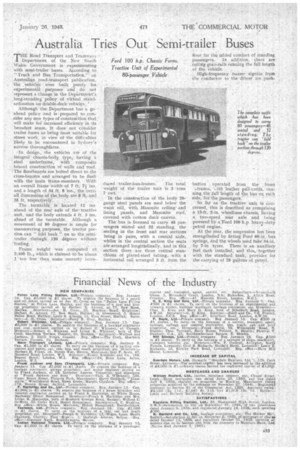Australia Tries Out Semi-trailer Buses
Page 35

If you've noticed an error in this article please click here to report it so we can fix it.
THE Road Transport and Tramway:,
Department of the New South Wales Government is experimenting with semi-trailer buses. According to "Truck and Bus Transportation," Australian road-transport publication. the vehicles Were built purely for experimental purposes and do not represent a change in the Department's long-standing policy of virtual standardization on elduble-deck vehicles.
Although the Department has a goahead policy and is prepared to consider any new types of construction that will make for increased efficiency in its broadest sense, it does not consider trailer buses as being most 'suitable for street work, in view of the difficulties likely to be encountered in Sydney's narrow thoroughfares.
-In design, the vehicles are of the integral chassis-body type, having a steel underframe,with composite braced construction of walls and roof. The floorboards are bolted direct to the cross-bearers and arranged to be flush with the main frame-members. With an overall frame width of 7 ft. 7/ ins. and a length of 84 It. 8 ins., the overall .dimensions of the body are 8 ft. and 35 ft. respectively.
The turntable is located 12 ins. ahead of the rear axle of the. tractive unit, and the body extends 4 ft. 3 ins, ahead of the turntable. Although a movement of 90 degrees is ample for tnanceuvring purposes, the tractor portion.ca,n "fold back" on to the.semi. trailer through 120 degrees without -fouling.
Frame weight was .computed at 2,400 lb., which is claimed to be about I ton less than some recently intro-.
duced trailer-bus-frames. The total weight of the trailer unit is 5 tons 7 cwt.
In the construction of the body 20gauge steel panels are used below the waist rail, with, Masonite ceiling and lining panels, and Masonite rocif, covered with cotton duck canvas.
The bus is licensed to carry 48 passengers seated and 32 standing, the seating in the front and rear sections being in pairs, with a central aisle, whilst in the central section the seats are arranged longittidinally, and in this section there are three central stanchions of plated-steel tubing, with a horizontal rail arranged 3 ft. from the floor for the added comfort of standing passengers. In addition, there are ceiling grab-rails running the full length of the vehicle.
High-frequency buzzer signals from the conductor to the driver are push
button operated from the front -.trance, ,..ith leather pill-cords, running the fulrlength of the bus on each Side, for the passengers.— So far as the tractive unit is concerned, this is described as comprising a 13-ft. 2-in. wheelbase chassis, having a two-speed rear axle and being powered by aTord I00 h.p. heavi-duty petrol engine.
At the rear, the suspension has been strengthened by fitting Ford 60-in, bus springs, and the wheels used take 34-in. by 7-in tyres. There is an. auxiliary fuel tank installed, and this, together with the standard tank, provides for the carrying of 28 gallons of petrol.




















































